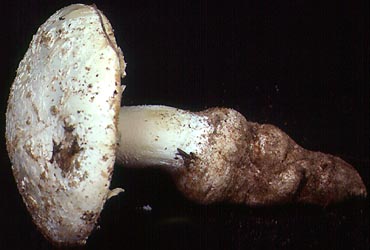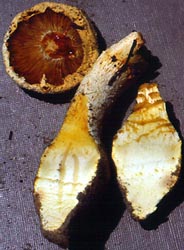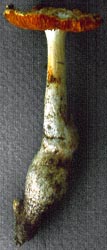[ Section Lepidella page. ]
[ Amanita Studies home. ]
[ Keys & Checklist/Picturebooks ]
[ New Jersey & region list ]
[ E. Texas & Gulf Coast list ]
"American Solitary Lepidella"
=Amanita solitariiformis (Murrill) Murrill
=Amanita crassifolia Bas nom. prov.






Technical description (t.b.d.)
BRIEF DESCRIPTION: The cap of Amanita subsolitaria is 50 - 100 mm wide, white to off-white to cream to dull yellow orange, sometimes with pinkish or tan tints, orangish near the margin in age, convex to plano-convex, slightly umbonate, tacky when moist, shiny when dry, with an incurved or downcurved, appendiculate, and nonstriate margin, sometimes short-striate in age. The volva is present as white, becoming pale gray subfelted to floccose patches or compressed (cake-like) warts at the center to scales at the margin or off-white scattered fine powder, easily removable. The flesh is white, unchanging or staining pale tan, 8 - 11 mm thick over the stem, thinning rapidly to a membrane in the last 5 - 6 mm.
The gills are free to narrowly adnate, crowded, growing cross-walls between them (anastomosing), sometimes forking (usually at least once or twice per fruiting body), pale orangish cream to yellowish cream to cream in mass, yellowish cream to cream in side view, 8.5 - 12 mm broad, with dense white flocculence on the edge. The short gills are rounded truncate to subtruncate to subattenuate to attenuate, unevenly distributed, of diverse lengths, and plentiful.
The stem is (30-) 50 - 104 × (5-) 9 - 15 mm, narrowing upward or cylindric or slightly narrowing downward, flaring at the top, white to whitish, pale buff above the ring (when present), faintly browning with handling, at first covered with dense, white flocculence. The bulb is (20-) 28 - 34 (-48) × 14 - 45 mm, carrot-shaped to narrowly turnip-shaped, and rooting. The ring is absent or present as a thick, white, flocculence, and high on the stem. The volva is absent or present as fine, thin lines around the top of the bulb, sometimes becoming brownish gray lines the day after collection. The flesh is cream to sordid yellowish cream and solid.
The odor is like disinfectant in the calcium chloride group or pungent and strong like subalkaline with a floral element or marshmallow-like.
Spores measure (7.3-) 9.1 - 14.0 (-21) x (3.5-) 4.2 - 5.2 (-6.0) µm and are cylindric to bacilliform (rarely elongate or ellipsoid) and amyloid. Clamps are present at bases of basidia.
Amanita subsolitaria grows with oak and pine and is a common species of the inner and outer coastal plain areas of New Jersey. Very frequently found in the sandy soils of the New Jersey Pine Barrens, it may also be found in clay of central New Jersey where there are mature oaks.
Its range extends from Florida to Massachusetts (Cape Cod), U.S.A.
Bas (1969) observed that Murrill might have named the same species twice (A. subsolitaria and A. solitariiformis). The only difference that Bas noted between them was that they differed in the structure of the universal veil--powdery in the former and rather robust and cake-like in the latter. However, as seen in the photograph above (top line, left) both these forms of volva can occur on a single cap. With the sole distinction between the taxa no longer sustainable, RET treats the species the names as synonyms.
In the eastern U.S., the odor of the present species is so distinctive that the mushroom could probably be identified by a blind-folded person if their genetics allowed them to detect the odor (apparently some persons cannot). From the attempts to describe the odor in the above description, the reader can see that American vocabulary is not very helpful in this regard. RET has detected the same odor in an undescribed species in the state of Mexico (Mexico). The Mexican species had the distinctive yellowish gills and a habit similar to that of A. subsolitaria, however, examination of spores found that the spores were nowhere near as elongated as those of the present species. The discussion of similar (sister) taxa north and south of the northern Mexican deserts can be found in Tulloss (2005).
Occasionally, the present species is found in a cluster with one or two of the specimens apparently "parasitized" or "diseased" by some organism or organisms that cause the fruiting body to develop slightly abnormally and to turn yellow (and sometimes bleed orange droplets) when cut and to have stunted or otherwise malformed spores. I refer to mushrooms having this reaction as "displaying the yellowing syndrome." To date attempts to culture non-Amanita organisms from such fruiting bodies have led to frustration with regard to finding an entity to which the yellowing can be attributed -- because of the large number of organisms that grow in the cultures. (See comments of Dr. Bas regarding his provisional taxon A. crassifolia, below.)
There is some evidence to suggest a "reddening syndrome" which stains the gills pinkish, salmon, or brick red or the flesh pinkish. For more on the reddening syndrome, see Amanita boudieri var. beillei (Beauseign.) Neville & Poumarat.
This species is rather closely related to A. rhoadsii (Murrill) Murrill. Together, they belong to Bas' stirps Rhoadsii.
I propose the "synonymy" of A. crasifolia Bas nom. prov. (an unvalidated name) with A. subsolitaria; and, hence, believe there is no point in validating the name. There follows a description of A. crassifolia coming in large part from that of Bas (1969):


The cap of Amanita crassifolia is 30 - 48 mm wide, convex to plano-convex, white to pale yellowish with a slight brownish tinge over the center or entirely yellow, dry to subviscid, with a nonsulcate, appendiculate margin. The cap is at first completely covered by flocculose-verruculose layer of volva, later glabrous and shiny with scattered, vague, thin, subfloccose crusts or patches of volva; remnants of volva in particular turn deep yellow when rubbed.
The gills are rather distant to distant, free, moderately broad, thick to very thick, white to cream or yellowish, and turning yellow to orange where bruised. The short gills are subtruncate to attenuate.
The stem is 40 - 80 x 5 - 9 mm, slightly tapering upward, solid, white to yellowish, and without distinct remnants of volva. Older wounds tend to become orange.
The spores measure (6.6-) 8.7 - 11.5 (-14.0) x (4.2-) 4.5 - 6.0 (-6.3) µm and are amyloid and elongate to cylindric. Clamps are perhaps present at bases of basidia.
This entity is known from deciduous woods and pine-oak woods in the eastern U.S.A. The material that Bas reviewed of his provisional species was from North Carolina, U.S.A.
I have twice collected material that I determined as A. crassifolia from New Jersey pine barrens and notably it is found a short distance from a site that produces prolific quantities of A. subsolitaria, both normal and yellowing. Bas placed A. crassifolia tentatively in his Amanita stirps Straminea. However, he considered it possible that the material he reviewed could be a "small, lutescent variety" of A. subsolitaria. The only distinction he noted was in the length of chains of inflated cells in the volvas of the two species. My microscopic observations are consistent with those of Dr. Bas.
Bas also considered the possibility that A. crassifolia was related to A. limbatula Bas.
However, he was unable to locate an outer membranous layer of the volva on the caps of the material
he reviewed; and he was unable to assess the volva at the base of the stem, because this area was badly damaged in
all material he reviewed.
-- R. E. Tulloss
Photos: R. E. Tulloss (New Jersey. Top row - cake-like warts on cap. Second row- granular warts on cap (left) and syringaldazine spot test demonstrating laccase concentration restricted to lower bulb. Third row - forked, yellowish gills of A. subsolitaria and a "parasitized," yellow-staining specimen.) Fourth row - two specimens determined as A. crassifolia nom. prov.)
[ top ]
[ Section Lepidella page. ]
[ Amanita Studies home. ]
[ Keys & Checklist/Picturebooks ]
[ New Jersey & region list ]
[ E. Texas & Gulf Coast list ]
Last change 15 March 2009.
This page is maintained by R. E. Tulloss.
Copyright 2003, 2004, 2006, 2008, 2009 by Rodham E. Tulloss.
Photographs copyright 2003 by Rodham E. Tulloss.